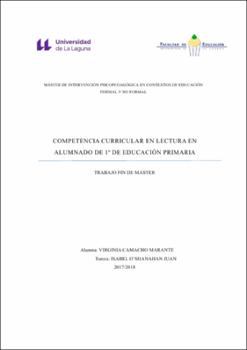Competencia curricular en lectura en alumnado de 1º de Educación Primaria
Fecha
2018Resumen
This study’s main objective is to determine if teachers are able to detect students at riskstatus in Reading learning, comparing their opinion and the student’s curricular
competence. It is also, to try to analyze if there are differences in performance between
students, who have learning to read based on different synthetic methods (syllabic and
phonological).
To do this, we selected a sample of 35 students from two primary school classrooms
and their teachers. We used different instruments to get information: CUDEA to collect
information about students’ performance on the part of the teachers; IPAL to know the
curricular level of the students; and semi structured interviews for teachers are situated
2
in a specific teaching method. On the one hand, the results show a significant
correlation between the teachers opinion and the curricular competence of the students.
On the other hand, making a comparison of the students according to each method, it
could be confirmed that the differences found between both are not remarkable. In this
way, the need for detection and prevention in the education system is accentuated,
before the possible difficulties translate into school failure. El presente estudio persigue la finalidad de averiguar si el profesorado es capaz de
detectar al alumnado en posible situación de riesgo en el aprendizaje de la lectura,
comparando su juicio frente a la competencia curricular de los estudiantes. En un
segundo plano, se intenta analizar si existen diferencias en el rendimiento entre
alumnado que ha aprendido a leer a partir de métodos sintéticos diferentes (silábico y
fonológico).
Para ello, se seleccionó una muestra de 35 alumnas y alumnos de dos aulas de primer
curso de Educación Primaria, así como a sus tutoras, y se emplearon diferentes
instrumentos de recogida de información: el CUDEA para recoger información sobre el
rendimiento del alumnado por parte del profesorado; el IPAL para conocer la
competencia curricular en lectura; y entrevistas semiestructuradas para situar a las
docentes en un método de enseñanza determinado. Por una parte, los resultados
muestran una correlación significativa entre el juicio de las docentes participantes y la
competencia curricular del alumnado y, por otro lado, haciendo una comparativa del
alumnado en función a cada método, podría afirmarse que no se aprecian diferencias
notables. De esta manera, se acentúa la necesidad de detección y prevención en el
sistema educativo, antes de que las posibles dificultades se traduzcan en fracaso escolar.




